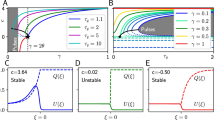Abstract
The olfactory receptor neuron provides a good opportunity to analyze a biophysical model of a single neuron because its dendritic structure is simple and even close to a cylinder in the case of the moth sex-pheromone receptor cell. We have considered this cylindrical case and studied two main problems. First, we were concerned with the effect of the neuron's length on the receptor potential for a constant stimulus-induced conductance change. An analytical solution for the receptor potential was determined by using input, resistances. It was shown that the longer the neuron, the greater its ability to code over a wide range of values of the intensity of the stimulus. Second, we studied numerically the passive backpropagation of action potentials into the dendrite and its influence on the firing frequency. While propagating along the dendrite the action potential decreases in amplitude and its shape becomes rounded. The firing frequency in the model with backpropagation was found to be greater than that obtained analytically in the absence of backpropagation. However, for any given conductance change, when normalized with respect to their maxima, both firing frequencies were found to be very similar over a wide range of parameter values. Therefore, the actual firing rate (with backpropagation) may be approximated by the analytical solution without backpropagation if the actual firing rate for a large conductance change is known.
Similar content being viewed by others
References
Abbott, L. F. 1992. Simple diagrammatic rules for solving dendritic cable problems.Phys. A 185, 343.
Abbott, L. F. 1994. Single neuron dynamics: An introduction. InNeural Modeling and Neural Networks, F. Ventriglia (Ed.). Oxford, UK: Pergamon Press.
Butz, E. G. and J. D. Cowan. 1974. Transient potentials in dendritic systems of arbitrary geometry.Biophys. J. 14, 661.
Claiborne, B. J., A. M. Zador, Z. F. Mainen and T. H. Brown. 1992. Computational models of hippocampal neurons. InSingle Neuron Computation, T. McKenna, J. Davis and S. F. Zornetzer (Eds.). p. 61. Boston, MA: Academic Press.
Hodgkin, A. L. and W. A. H. Rushton. 1946. The electrical constants of a crustacean nerve fibre.Proc. Roy. Soc. London Ser. B 133, 444.
Kaissling, K.-E. 1971. Insect olfaction. InHandbook of Sensory Physiology, IV: Chemical Senses, L. M. Beidlen (Ed.), Part 1. Berlin, Germany: Springer-Verlag.
Kaissling, K.-E. 1986. Chemo-electrical transduction in insect olfactory receptors.Ann. Rev. Neurosci. 9, 121.
Kaissling, K.-E. 1987.R. H. Wright Lectures on Insect Olfaction, K. Colbow (Ed.), Burnaby, Canada: Simon Fraser University.
Keil, T. A. 1984. Reconstruction and morphometry of silkmoth olfactory hairs: A comparative study of sensilla trichodea on the antennae of maleAntheraea polyphemus andAntheraea pernyi (Insecta, Lepidoptera).Zoomorphology 104, 147.
Lamb, T. D. and E. N. Pugh Jr. 1992. G-protein cascades: gain and kinetics.Trends in Neurosci. 15, 291.
Lánský, P., J.-P. Rospars and A. Vermeulen. 1994. Basic mechanisms of coding stimulus intensity in the olfactory sensory neuron.Neural Process. Lett. 1, 9.
Mascagni, M. V. 1989. Numerical methods for neuronal modeling. InMethods in Neural Modeling: From synapses to networks, C. Koch and I. Segev (Eds.), p. 439. Cambridge, MA: The MIT Press.
Rall, W. 1960. Membrane potential transients and membrane time constants of motoneurons.Exp. Neurol. 2, 503.
Rall, W. 1962. Theory of physiological properties of dendrites.Ann. N.Y. Acad. Sci. 96, 1071.
Rall, W. 1964. Theoretical significance of dendritic trees for neuronal input-output relations. InNeural Theory and Modeling, R. Reiss (Ed.). Stanford, CA: Stanford University Press.
Rall, W. 1977. Core conductor theory and cable properties of neurons. InHandbook of Physiology: The Nervous System, E. R. Kandel (Ed.), Vol. 1. Bethesda, MD: American Physiological Society.
Rall, W. 1989. Cable theory for dendritic neurons. InMethods in Neural Modeling: From synapses to networks, C. Koch and I. Segev (Eds.), p. 9. Cambridge, MA: The MIT Press.
Rospars, J.-P., P. Lánský, H. C. Tuckwell and A.Vermeulen. 1995. Coding of odor intensity in a deterministic model of first-order olfactory neurons.J. Comp. Neurosci. To appear.
Segev, I. 1992. Single neurone models: oversimple, complex and reduced.Trends Neurosci. 15, 414.
Segev, I., M. Rapp, Y. Manor and Y. Yarom. 1992. Analog and digital processing in single nerve cells: dendritic integration and axonal propagation. InSingle Neuron Computation, T. McKenna, J. Davis and S. F. Zornetzer (Eds.), p. 173. Boston, MA: Academic Press.
Spruston, N., D. B. Jaffe and D. Johnston, 1994. Dendritic attenuation of synaptic potentials and currents: role of passive membrane properties.Trends Neurosci. 17, 161.
Stengl, M., H. Hatt and H. Breer. 1992. Peripheral processes in insect olfaction.Annu. Rev. Physiol. 54, 665.
Tuckwell, H. C. 1988a.Introduction to Theoretical Neurobiology, Vol. 1. Cambridge, UK: Cambridge University Press.
Tuckwell, H. C. 1988b.Introduction to Theoretical Neurobiology, Vol. 2. Cambridge, UK: Cambridge University Press.
Vermeulen, A., J.-P. Rospars, P. Lánský and H. C. Tuckwell. 1995. Some new results on the coding of pheromone intensity in an olfactory sensory neuron. InThird European Symposium on Artificial Neural Networks, M. Verleysen (Ed.), p. 105. Brussels, Belgium: D. Facto.
Wilson, C. J. 1992. Dendritic morphology, inward rectification, and the functional properties of neostriatal neurons. InSingle Neuron Computation, T. McKenna, J. Davis and S. F. Zornetzer (Eds.), p. 141. Boston, MA: Academic Press.
Walsh J. B. and H. C. Tuckwell. 1985. Determination of the electrical potential over dendritic trees by mapping onto a nerve cylinder.J. Theor. Neurobiol. 4, 2.
Author information
Authors and Affiliations
Rights and permissions
About this article
Cite this article
Vermeulen, A., Rospars, J.P., Lánský, P. et al. Coding of stimulus intensity in an olfactory receptor neuron: Role of neuron spatial extent and passive dendritic backpropagation of action potentials. Bltn Mathcal Biology 58, 493–512 (1996). https://doi.org/10.1007/BF02460594
Received:
Issue Date:
DOI: https://doi.org/10.1007/BF02460594




